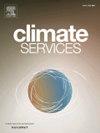Predicting precipitation and NDVI utilization of the multi-level linear mixed-effects model and the CA-markov simulation model
IF 4
3区 环境科学与生态学
Q2 ENVIRONMENTAL SCIENCES
引用次数: 0
Abstract
The current work intends to reconstruct the spatiotemporal evolution of precipitation and the Normalized Differentiate Vegetation Index (NDVI) in the Loukkos watershed and provide scenarios for their recent and future evolution, therefore determining the degree of association. We conducted a study on the time series data of precipitation and NDVI from 1999 to 2019. The NDVI prediction is conducted using the CA-Markov model and the linear mixed-effects multi-level model (LME) with precipitation data from 2019 to 2040. The CA-Markov model was employed to predict the vegetation indices for 2029 and 2040 using 1999, 2009, and 2019 data. The model simulates future precipitation estimates for up to 2040 using different daily precipitation data series obtained from ten meteorological stations between 1999 and 2019. The accuracy of NDVI simulation is evaluated using kappa indices, specifically of 88%, of 86%, and of 83%, indicating that the consistency between the simulated NDVI map of 2019 and the actual one is nearly perfect, indicating statistical reliability of our model. The precipitation forecast for the Loukkos watershed predicts that average annual precipitation will decrease by 11.4% between 1999 and 2040. In contrast, based on 2019, there will be an increase in low vegetation areas and a decline in dense regions in the eastern and western parts of the basin in 2029 (−12.89%) and 2040 (−12.78%), respectively. The findings of this study suggest that by 2040, the Loukkos watershed will be exposed to future climate hazards, such as reduced precipitation and vegetation. The integration of geoinformation and prediction models is a great resource for optimizing environmental planning to prepare and potentially mitigate the harmful effects of climate change and its consequences for both humanity and the environment.

求助全文
约1分钟内获得全文
求助全文
来源期刊

Climate Services
Multiple-
CiteScore
5.30
自引率
15.60%
发文量
62
期刊介绍:
The journal Climate Services publishes research with a focus on science-based and user-specific climate information underpinning climate services, ultimately to assist society to adapt to climate change. Climate Services brings science and practice closer together. The journal addresses both researchers in the field of climate service research, and stakeholders and practitioners interested in or already applying climate services. It serves as a means of communication, dialogue and exchange between researchers and stakeholders. Climate services pioneers novel research areas that directly refer to how climate information can be applied in methodologies and tools for adaptation to climate change. It publishes best practice examples, case studies as well as theories, methods and data analysis with a clear connection to climate services. The focus of the published work is often multi-disciplinary, case-specific, tailored to specific sectors and strongly application-oriented. To offer a suitable outlet for such studies, Climate Services journal introduced a new section in the research article type. The research article contains a classical scientific part as well as a section with easily understandable practical implications for policy makers and practitioners. The journal''s focus is on the use and usability of climate information for adaptation purposes underpinning climate services.
 求助内容:
求助内容: 应助结果提醒方式:
应助结果提醒方式:


